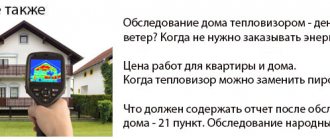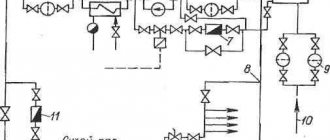Types of fan heaters
Equipment of this class are effective devices for heating any room using directed hot air. The efficiency of any heat gun reaches almost 100%. The following varieties of these products are available for sale:
- Electric - they work for heating only if there is a household power supply.
- Diesel - the operating principle is based on burning fuel in a combustion chamber with subsequent heating of the air flow.
- Gas - the principle is similar to the second option, but they run on blue fuel, they are much more economical because gas is cheaper.
Each type has its own specific features, advantages and small disadvantages.
Electrical
Electric fan heaters have the following advantages:
- small dimensions allow the product to be installed in almost any room;
- full automatic control;
- silent operation;
- quite high level of fire safety.
The disadvantages include the high cost of electrical energy. In addition, before installing the heat gun, it is necessary to check the wiring so that it can withstand the voltage from using such equipment. Devices must have overheating protection and automation to maintain an optimal constant temperature.
Diesel
These products have two types of heating: direct and indirect. In the first option, the room is heated by air flow, which contains combustion products, so it is necessary to install supply ventilation. In the case of indirect heating, the heat gun has a design that allows combustion products to be removed from the combustion chamber through a special pipe, which simply needs to be connected to a chimney pipe or a corrugated hose.
When choosing a heat gun for the garage, you need to think through and calculate all the options - take into account the volume of the room, how to remove combustion products. Without a doubt, a device with indirect heating is much better than an analogue with a direct heating method, when there is a danger of smoke in the entire room.

Experts consider the following indicators to be advantages:
- economical fuel consumption;
- heat guns of this class operate for up to 14 hours on one tank refill;
- effective heating of a garage of any size, even two floors.
The disadvantages are the cost of diesel fuel, and the smell of burnt diesel fuel leaves an unpleasant odor that is not removed by any ventilation system.
Gas
Such guns have a number of advantages over their diesel counterparts:
- heat the room much faster;
- heating of this type is many times more economical due to lower gas consumption and cost;
- there is a sensor that reads the concentration of carbon dioxide;
- automation that controls equipment overheating;
- propane or butane burns completely - there is no need to install a special exhaust system, ordinary ventilation, which is found in every garage, is sufficient.
There is one, but quite significant, drawback: for the unit to function, you need a liquefied gas cylinder, which is quite difficult to get.
Advice! If the garage does not have good ventilation, then all the options will not suit you; the room will not be heated to its full extent due to frequent ventilation by opening the gate.
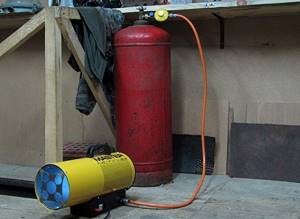
What parameters are used to select a garage heating device?
A garage is not only a room for storing a car from precipitation and cold, it can also be used as a workshop (see Arranging a garage for a workshop), where minor car repairs are carried out, which is quite difficult to do in the cold season without heating the garage.
If there are communications, this issue disappears; if they are absent, you can only rely on autonomous heating systems. One of them is heat guns, which are capable of heating a large room in a fairly short period of time and then maintaining the desired temperature in it.
The garage heating gun is selected based on its type and power.
To do this you need to consider:
- Garage area.
- How high-quality is the insulation in the garage (see Insulation of the garage: materials and rules for performing the work) or lack thereof.
- How long will people stay here?
According to the type of thermal energy source used in the devices, garage heat guns are:
- Gas.
Heating a garage with gas guns is the optimal choice of unit in terms of power, efficiency and speed of heating the room. But it cannot be used in a room where people are constantly present.
During the heating process, the combustion products released will accumulate in the garage and poison the human body. And constant ventilation helps heat escape to the street. Therefore, heating a garage with a gas gun is not recommended and can even be dangerous.
Tip: A gas gun can be used if you need to quickly heat up a room, but not for constant use. For an hour of operation of such a device with a power of 10 - 15 kW, you will need 0.5 liters of liquefied gas.
- Diesel . This is the most economical option to use. Diesel devices come in direct heating, where combustion products remain indoors, and indirect heating – the burnt fuel is removed outside. However, to maintain combustion, the unit takes air from a room that needs frequent ventilation.
- Electric. These are the simplest garage heating devices. It consists of a heating element that warms the air and a fan that forces it into the room. Their operating mode is carried out using a thermostat. However, difficulties may arise here when using devices in unreliable power lines, when they cannot withstand heavy loads, which requires attention when choosing a unit. In addition, high energy consumption means additional material costs.
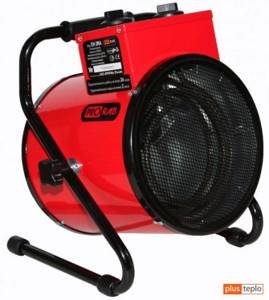
Electric heat gun
- Combined. In this case, it is better to purchase two guns - gas and diesel. The first quickly warms up the room, and the second maintains the desired temperature in the room, removing harmful combustion products outside.
Tip: If a diesel gun is provided with air flow from the street, it will be able to work for a long time without ventilating the room.
Choosing a heat gun
The main parameter when choosing a product is its power; excess power will waste the meter, and a deficiency will simply not be able to provide sufficient heating of the garage. Experts, through measurements and various experiments, have established that 10 m2 of any private garage can be heated with 1 kW of thermal power if the ceiling height is within 3 m.
Therefore, in the case when the area of your premises is no more than 25 square meters. m, then you need to buy a device with a power of at least 2.5 kW, and given the severe frosts, it won’t hurt to increase the power to 5 kW. It should be taken into account that you will turn on the unit at full power only in exceptional cases. Which gun is right for you - decide for yourself.
Insulation of the garage
Before installing any type of heater or fan heater, you need to take care of additional insulation of the garage, especially the gate: the fewer heat leaks, the longer the garage will maintain an acceptable temperature. Otherwise, the gun will work to heat the space surrounding the garage, i.e. constantly.
Car enthusiasts should not forget that this room serves not only to shelter the car from weather disasters and thieves, but also for minor repairs and preventative maintenance. In particularly severe frosts, when you decide to thoroughly warm up the room, condensation may form on the iron gates due to the temperature difference, which will negatively affect the metal.
The optimal temperature for high-quality storage of equipment in winter is +50C.
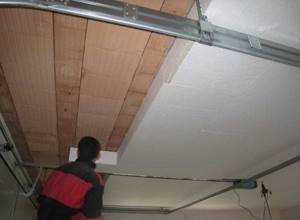
To properly insulate walls, use sheets of special foam plastic or penoizol. The latter material is considered the most progressive type of insulation; it retains heat much better, is very similar to polyurethane foam in thermal conductivity, but is much cheaper.
We insulate the ceiling in the same way, but for the gate there are several options:
- foam blocks - retain heat well and do not absorb moisture;
- extruded polystyrene foam - has even better rigidity and retains heat well;
- foil foamed polyethylene - differs in that one side is covered with foil, used in combination with the first types of insulation.
During all insulation work, it is necessary to resolve the issue of better ventilation. To do this, you can make a hood directly from the interior of the garage - direct access to the outside. A cement-asbestos pipe of standard diameter and size will be sufficient.
Features of using guns
Today, electric fan heaters of various types and devices are considered the most popular for quickly heating a garage, although the condition of the wiring leaves much to be desired. Therefore, fire inspectors like to visit such public places to draw up reports of various violations.
It is no secret that the indirect cause of all fires in garages is the improper use of heaters of various types, from homemade to factory-made models. As a rule, the fault here is 100% of the users: before connecting an electric gun of any power, you need to consult with energy network specialists. In addition, you must follow certain operating rules for products of any kind.
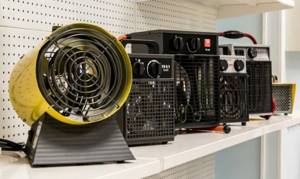
- After purchasing the equipment, you need to let it sit in a warm place for at least 2 hours.
- If this is a diesel version or a gas heat gun, purchased specifically for a pre-insulated garage, it is better to start them for the first time in the open air so that the factory lubricant burns.
- Before turning on the electric option, you must check for the presence of condensation on the heating elements, and also inspect the grounding of the garage wiring.
- A gun operating on waste oil is checked for the presence of foreign objects in the fuel tank before filling with fuel.
- When using a chimney, it must have good draft and a minimum of bends.
- When connecting a gas gun, check all connections for leaks, otherwise the first activation may be the last.
The device must be installed only on a flat surface, the distance from the outlet nozzle to walls or other objects is at least 3 m, 0.5 m on the sides is enough, and 1.5 m on top. Such precautions are necessary so that the flow of forced air spreads freely throughout room.
As for the cost: diesel devices are considered the most expensive: their price starts from $200, gas ones are in the middle position around $150, and electric options start from $50. Having made the right choice, you will forget about frozen hands and an engine that won’t start due to the cold for at least six months - working in the garage will be comfortable, even though there is severe frost outside the gate.
Design features and heating principle
Heat guns are portable or stationary structures used to quickly warm small rooms. There are several varieties, most of which operate on the principle of a heat fan. Infrared units that warm objects to further reflect heat are also common.
The main elements of a heating device are: a heating element, a fan, a cylinder, and a pipe of a certain diameter used for supplying gas in the corresponding models. Due to the cylindrical body, air flows through the heating element and warms the garage after reaching a high temperature.


